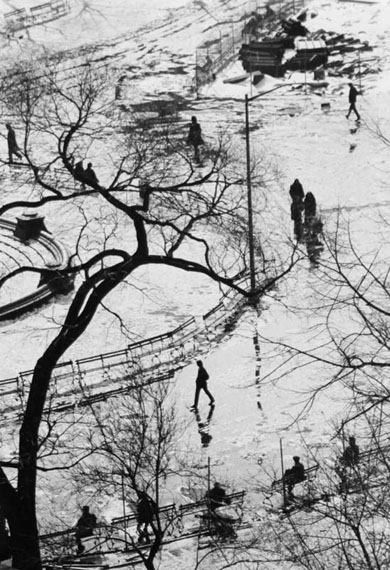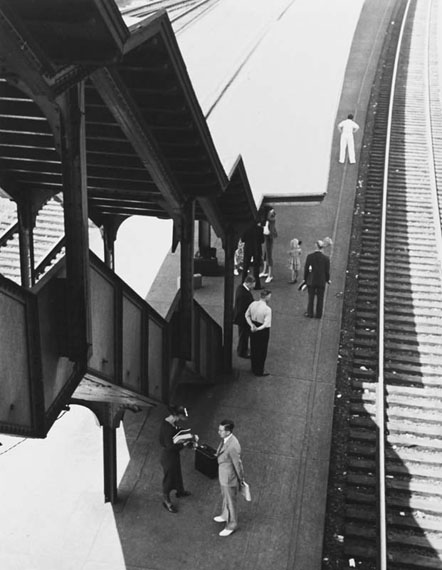
Snow Scene, Washington Square Park, 1970
Vintage gelatin silver print
Image: 9 ¾ x 6 ¾ inches
Stamped and annotated
“© ANDRE KERTÉSZ” in artist’s hand in pencil on verso
André Kertész »
Converging Journeys in the Modernist Age
An exhibition with Theodore Fried
Exhibition: 12 Nov – 28 Dec 2013
Thu 14 Nov 18:00 - 20:00

Madelyn Jordon Fine Art
37 Popham Road
NY 10583 Scarsdale
+1-914-7238738
info@madelynjordonfineart.com
www.madelynjordonfineart.com
Tue-Sat 10-17:30

Chagall Family Picnic, 1933
Gelatin silver print
Image: 10 ½ x 13 ½ inches
Signed on recto “A. Kertész”
ANDRÉ KERTÉSZ & THEODORE FRIED
CONVERGING JOURNEYS IN THE MODERNIST AGE
Exhibition: November 12 – December 29, 2013
Co-curated by Milton J. Ellenbogen
Madelyn Jordon Fine Art is pleased to announce ANDRÉ KERTÉSZ & THEODORE FRIED: CONVERGING JOURNEYS IN THE MODERNIST AGE, a show of photographs, paintings, works on paper and prints by the Hungarian – American Modernist artists, André Kertész and Theodore Fried. It is the first exhibition of the works of these two artists at the gallery since 2002.
Born in Hungary near the turn of the 20th century, Kertész the pioneer photographer and Fried, an oil painter and master etcher, were destined to meet and work in Paris, escape the Nazis and the Holocaust and carry on their long and illustrious careers living a half-mile apart in New York’s Greenwich Village. This show evidences their progression, which in essence parallels most of the major art movements of their time.
The exhibition includes over 15 photographs by Kertesz, which spans the artist’s aesthetic journey, from the formative Paris years of the 1920’s -1930’s to mature works in the US, from the late 1930’s – 1970’s.
Born in Budapest in 1894, Kertész was conscripted into the army. He had already acquired a camera as a gift and was fascinated by what he could do with it, taking pictures of fellow soldiers at the front and experimenting with nature scenes such as the patterns formed by the reflection and refraction of water, and the unconscious fear and imagination inherent in shadows. In 1925, at the age of 30, he journeyed to Paris where he heard many artists had ventured seeking to make new friends and to achieve a degree of fame.
Kertész and Fried met at the Café du Dome in Paris and they became fast friends, meeting many times at their mutual hangout and eventually meeting other artist émigrés like Chagall, Brassai, Cartier-Bresson, and Jacques Lipchitz. As young artists in early 20th century Paris, the artistic center of Europe, they assimilated the progressive ideas of expressionism, surrealism and cubism, which became the framework for their artistic practices.
�

Meudon, 1928
Gelatin silver print
Image: 9.7 x 7.8 inches
Printed by Igor Bakht
Magnum Stamp
In Paris, Kertész was at the forefront of many of the aesthetic developments in photography. He was an early user of the Leica camera, which allowed him to explore the city with great ease, at night, from high above and at acute angles. In Meudon, Kertész delightfully conveys the texture of Paris, capturing a quirky scene of disconnecting incidents occurring at the same time. He emphasized the geometry of the scene with the transecting angles of the bridge against the perspective of the building rooftops and the uphill angle of dirt and construction at the bend in the road where three gentlemen are walking.
Kertész emigrated to America in 1936 where he had been engaged by Keystone Agency, but he remained with them only one year. Unable to return to Paris due to the progress of World War II, Kertesz remained trapped in NY. In the ensuing years, he struggled to exhibit his personal work to an American audience, becoming disillusioned. He spent much of his time employed by Conde Nast, photographing homes of famous people.
In 1964, interest in Kertesz was reawakened when John Sarkowski, curator of photography at the Museum of Modern Art in New York, organized a solo exhibition of Kertesz’s work. Thereafter, and throughout the 1960’s, 1970’s and 1980’s, Kertesz was exhibited regularly, and recognized for his genius and importance in the history of photography.
Kertész received many honors in his lifetime (1894—1985) mainly in France, Hungary and America. Hilton Kramer, late art critic of the NY Times, gave the eulogy at his funeral in 1985 and noted that few artists had the longevity of Andre Kertesz who lived to finally be recognized for his outstanding work and to realize fame in his lifetime. After his death, the Metropolitan Museum of Art finally gave Kertész what he had sought the most: a huge comprehensive show spanning some 50 years of his work, especially highlighting his innovation and creativity in the field of photography.�

Poughkeepsie, 1937
Mid-vintage gelatin silver print
Image: 12 ¾ x 11 inches
Agfa Portaga Rapid warm tone paper
Printed at Modern Age Lab by Igor Bakht
Signed and dated in artist’s hand on verso
“Photo by Kertészz” stamp